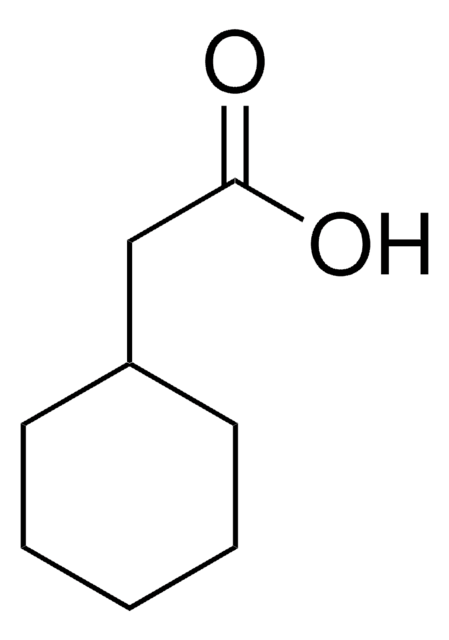101834
Cyclohexanecarboxylic acid
98%
Synonyme(s) :
Hexahydrobenzoic acid
About This Item
Produits recommandés
Pureté
98%
Forme
solid
Indice de réfraction
n20/D 1.461 (lit.)
Point d'ébullition
232-233 °C (lit.)
Pf
29-31 °C (lit.)
Solubilité
H2O: soluble 0.201g in 100g at 15 °C
organic solvents: soluble
Densité
1.033 g/mL at 25 °C (lit.)
Chaîne SMILES
OC(=O)C1CCCCC1
InChI
1S/C7H12O2/c8-7(9)6-4-2-1-3-5-6/h6H,1-5H2,(H,8,9)
Clé InChI
NZNMSOFKMUBTKW-UHFFFAOYSA-N
Vous recherchez des produits similaires ? Visite Guide de comparaison des produits
Catégories apparentées
Application
Actions biochimiques/physiologiques
Notes préparatoires
Mention d'avertissement
Warning
Mentions de danger
Conseils de prudence
Classification des risques
Acute Tox. 4 Oral - Eye Irrit. 2
Code de la classe de stockage
11 - Combustible Solids
Classe de danger pour l'eau (WGK)
WGK 3
Point d'éclair (°F)
Not applicable
Point d'éclair (°C)
Not applicable
Équipement de protection individuelle
dust mask type N95 (US), Eyeshields, Gloves
Certificats d'analyse (COA)
Recherchez un Certificats d'analyse (COA) en saisissant le numéro de lot du produit. Les numéros de lot figurent sur l'étiquette du produit après les mots "Lot" ou "Batch".
Déjà en possession de ce produit ?
Retrouvez la documentation relative aux produits que vous avez récemment achetés dans la Bibliothèque de documents.
Les clients ont également consulté
Notre équipe de scientifiques dispose d'une expérience dans tous les secteurs de la recherche, notamment en sciences de la vie, science des matériaux, synthèse chimique, chromatographie, analyse et dans de nombreux autres domaines..
Contacter notre Service technique









